Estimation and Prediction of Industrial VOC Emissions in Hebei Province, China
Abstract
:1. Introduction
2. Materials and Methods
2.1. Study Area
2.2. Methodology
2.3. Data Collection
2.3.1. Activity Data
2.3.2. Emission Factors
2.4. Scenario Designed
3. Results and Discussion
3.1. Industrial VOC Emission Inventory for 2015
3.1.1. Emission Contributions by Source
3.1.2. Spatial Distribution of Industrial VOC Emissions
3.2. Scenario Prediction of Industrial VOC Emissions in 2020 and 2030
3.3. Uncertainty Analysis
4. Conclusions
Author Contributions
Funding
Acknowledgments
Conflicts of Interest
References
- Atkinson, R.; Arey, J. Atmospheric Degradation of Volatile Organic Compounds. Chem. Rev. 2003, 103, 4605–4638. [Google Scholar] [CrossRef] [PubMed]
- International Agency for Research on Cancer. IARC Monographs on the Evaluation of Carcinogenic Risks to Humans; IARC: Lyon, France, 2018; Volume 120. [Google Scholar]
- Zheng, C.H.; Shen, J.L.; Zhang, Y.X.; Huang, W.W.; Zhu, X.B.; Wu, X.C.; Chen, L.H.; Gao, X.; Cen, K.F. Quantitative assessment of industrial VOC emissions in China: Historical trend, spatial distribution, uncertainties, and projection. Atmos. Environ. 2017, 150, 116–125. [Google Scholar] [CrossRef]
- Gong, F. Anthropogenic Volatile Organic Compounds Emission Inventory and Characteristics. Master’s Thesis, Xi’an University of Architecture and Technology, Xi’an, China, May 2013. (In Chinese). [Google Scholar]
- Huang, W.W. Characteristics of Industrial VOCs Emissions and Evaluation of Control Technology in China. Master’s Thesis, Zhejiang University, Zhejiang, China, March 2016. (In Chinese). [Google Scholar]
- Piccot, S.D.; Watson, J.J.; Jones, J.W. A global inventory of volatile organic compound emissions from anthropogenic sources. J. Geophys. Res. 1992, 97, 9897–9912. [Google Scholar] [CrossRef]
- Rajabi, H. Hadi Mosleh, M.; Mandal, P.; Lea-Langton, A.; Sedighi, M. Emissions of volatile organic compounds from crude oil processing—Global emission inventory and environmental release. Sci. Total Environ. 2020, 727, 138654. [Google Scholar] [CrossRef] [PubMed] [Green Version]
- Benjamin, M.T.; Mark, S.; Vorstatz, D.; Winter, A.M. A spatially and temporally resolved biogenic Hydrocarbon Emission Inventory for the California south coast air basin. Atmos. Environ. 1998, 31, 3087–3100. [Google Scholar] [CrossRef]
- Dommen, J.; Prevot, A.S.H.; Baertsch-Ritter, N.; Maffeis, G.; Ongoni, G.L.M.; Grüebler, F.C.; Thielmannc, A. High-resolution emission inventory of the Lombardy region: Development and comparison with measurements. Atmos. Environ. 2003, 37, 4149–4161. [Google Scholar] [CrossRef]
- Gallego, E.; Roca, F.J.; Perales, J.F.; Guardino, X.; Gadea, E.; Garrote, P. Impact of formaldehyde and VOCs from waste treatment plants upon the ambient air nearby an urban area (Spain). Sci. Total Environ. 2016, 568, 369–380. [Google Scholar] [CrossRef] [PubMed]
- Aleksandropoulou, V.; Torseth, K.; Lazaridis, M. Atmospheric Emission Inventory for Natural and Anthropogenic Sources and Spatial Emission Mapping for the Greater Athens Area. Water Air Soil Pollut. 2011, 219, 507–526. [Google Scholar] [CrossRef]
- Patrik, F.; Illerup, J.B. Danish emission inventory for solvents used in industries and households. Atmos. Environ. 2008, 42, 7947–7953. [Google Scholar]
- Singh, A.P.; Singh, R.; Usha, M.; Manesh Pratap, S.; Chandra Kumar, V. Emissions of monoterpene from tropical Indian plant species and assessment of VOC emission from the forest of Haryana state. Atmos. Pollut. Res. 2011, 2, 72–79. [Google Scholar] [CrossRef] [Green Version]
- Dominutti, P.; Keita, S.; Bahino, J.; Colomb, A.; Liousse, C.; Yoboué, V.; Galy-Lacaux, C.; Morris, E.; Bouvier, L.; Sauvage, S.; et al. Anthropogenic VOCs in Abidjan, southern West Africa: From source quantification to atmospheric impacts. Atmos. Chem. Phys. 2019, 19, 11721–11741. [Google Scholar] [CrossRef] [Green Version]
- Yang, G.H.; Jo, Y.J.; Lee, H.J.; Song, C.K.; Kim, C.H. Numerical Sensitivity Tests of Volatile Organic Compounds Emission to PM2.5 Formation during Heat Wave Period in 2018 in Two Southeast Korean Cities. Atmosphere 2020, 11, 331. [Google Scholar] [CrossRef] [Green Version]
- Klimont, Z.; Streets, D.G.; Gupta, S.; Cofala, J.; Fu, L.X.; Ichikawa, Y. Anthropogenic emissions of non-methane volatile organic compounds in China. Atmos. Environ. 2002, 36, 1309–1322. [Google Scholar] [CrossRef]
- Wei, W. Study on Current and Future Anthropogenic Emission of Volatile Organic Compounds in China. Ph.D. Thesis, Tsinghua University, Beijing, China, June 2009. (In Chinese). [Google Scholar]
- Liu, J.F.; Zhao, J.; Li, T.T.; Bai, Y.H.; Liu, Z.R. Establishment of Chinese Anthropogenic Source Volatile Organic Compounds Emission Inventory. China Environ. Sci. 2008, 28, 496–500. (In Chinese) [Google Scholar]
- Zhao, B.; Wang, P.; Ma, J.Z.; Zhu, S.; Pozzer, A.; Li, W. A high-resolution emission inventory of primary pollutants for the Huabei region, China. Atmos. Chem. Phys. 2012, 12, 481–501. [Google Scholar] [CrossRef] [Green Version]
- Wu, X.L. Study on Air Pollution Emission Inventory for Yangtze River Delta. Master’s Thesis, Fudan University, Shanghai, China, May 2009. (In Chinese). [Google Scholar]
- Zheng, J.Y.; Zheng, Z.Y.; Yu, Y.F.; Zhong, L.J. Temporal, spatial characteristics and uncertainty of biogenic VOC emission in the Pearl Delta region. Atmos. Environ. 2010, 44, 1960–1969. [Google Scholar] [CrossRef]
- Yu, Y.F.; Lu, Q.; Zheng, J.Y.; Zhong, L.J. VOC emission inventory and its uncertainty from the key VOC-related industries in the Pearl River Delta Region. China Environ. Sci. 2011, 31, 195–201. (In Chinese) [Google Scholar]
- Zheng, J.; Shao, M.; Che, W.; Zhang, L.; Zhong, L.; Zhang, Y.; Streets, D. Speciated VOC emission inventory and spatial patterns of ozone formation potential in the Pearl River Delta, China. Environ. Sci. Technol. 2009, 43, 8580–8586. [Google Scholar] [CrossRef]
- Fu, X.; Wang, S.X.; Zhao, B.; Xing, J.; Cheng, Z.; Huan, L.; Hao, J.M. Emission inventory of primary pollutants and chemical speciation in 2010 for the Yangtze River Delta region, China. Atmos. Environ. 2013, 70, 39–50. [Google Scholar] [CrossRef]
- 2016 China Ecology and Environment Status Bulletin. Available online: http://www.mee.gov.cn/hjzl/sthjzk/zghjzkgb/201706/P020170605833655914077.pdf (accessed on 15 February 2021). (In Chinese)
- Yang, L.X. Study on Temporal-Spatial Characteristic and Control Strategy of Industrial Emissions of Volatile Organic Compounds in China. Master’s Thesis, South China University of Technology, Guangzhou, China, June 2012. (In Chinese). [Google Scholar]
- Wei, W.; Wang, S.X.; Hao, J.M.; Cheng, S.Y. Projection of anthropogenic volatile organic compounds (VOCs) emissions in China for the period 2010–2020. Atmos. Environ. 2011, 45, 6863–6871. [Google Scholar] [CrossRef]
- Wei, W.; Cheng, S.Y.; Li, G.H.; Wang, G.; Wang, H.Y. Characteristics of volatile organic compounds (VOCs) emitted from a petroleum refinery in Beijing, China. Atmos. Environ. 2014, 89, 358–366. [Google Scholar] [CrossRef]
- Zhang, Y.L.; Yang, W.Q.; Simpson, I.; Huang, X.Y.; Yu, J.Z.; Huang, Z.H.; Wang, Z.Y.; Zhang, Z.; Liu, D.; Huang, Z.Z.; et al. Decadal changes in emissions of volatile organic 398 compounds (VOCs) from on-road vehicles with intensified automobile pollution control: Case study in a busy urban tunnel in 399 south China. Environ. Pollut. 2018, 233, 806–819. [Google Scholar] [CrossRef] [Green Version]
- 2016 China Statistical Yearbook (in Chinese). Available online: http://tongji.cnki.net.libproxy.bjut.edu.cn (accessed on 15 February 2021).
- General Situation of Industrial Economy in Hebei Province. Available online: http://gxt.hebei.gov.cn/hbgyhxxht/xxgk6/hbsgyjjgk82/index.html (accessed on 23 March 2021). (In Chinese)
- 2015 Hebei Economic Yearbook. Available online: http://tongji.cnki.net.libproxy.bjut.edu.cn (accessed on 15 February 2021). (In Chinese).
- Technical Guide on Compiling Atmospheric Volatile Organic Compounds Source Inventory (for Trial Implementation) (in Chinese). Available online: http://www.mee.gov.cn/gkml/hbb/bgg/201408/W020140828351293705457.pdf (accessed on 15 February 2021).
- Chen, S.P.; Liu, W.T.; Ou-Yang, C.F.; Chang, J.S.; Wang, J.L. Optimizing the emission inventory of volatile organic compounds (VOCs) based on network observations. Atmos. Environ. 2014, 84, 1–8. [Google Scholar] [CrossRef]
- Townsend-Small, A.; Marrero, J.E.; Lyon, D.R.; Simpson, I.J.; Meinardi, S.; Blake, D.R. Integrating source apportionment tracers into a bottom-up inventory of methane emissions in the barnett shale hydraulic fracturing region. Environ. Sci. Technol. 2015, 49, 8175–8182. [Google Scholar] [CrossRef] [Green Version]
- Wang, Y.N.; Ye, D.Q.; Lin, J.M.; Ye, C.D.; Fu, M.L. A study on emission characteristics of volatile organic compounds (VOCs) from enameled wire industry. China Environ. Sci. 2012, 32, 980–987. (In Chinese) [Google Scholar]
- Zhou, Y.; Cheng, S.Y.; Chen, D.S.; Lang, J.L.; Zhao, B.B.; Wei, W. A new statistical approach for establishing high-resolution emission inventory of primary gaseous air pollutants. Atmos. Environ. 2014, 94, 392–401. [Google Scholar] [CrossRef]
- Chen, Y. Study on Current and Future Industrial Emission of Volatile Organic Compounds in China. Master’s Thesis, South China University of Technology, Guangzhou, China, June 2011. (In Chinese). [Google Scholar]
- 2016 China Energy Statistical Yearbook. Available online: http://tongji.cnki.net.libproxy.bjut.edu.cn (accessed on 15 February 2021). (In Chinese).
- Statistical Bulletin of National Economic and Social Development in Hebei Province. Available online: http://www.hetj.gov.cn/res/uploadfile/20160229145526889.pdf (accessed on 15 February 2021). (In Chinese)
- The 12th Five Year Plan of petroleum and chemical industry in Hebei Province. Available online: http://www.hebei.gov.cn/hebei/14462058/14462085/14471257/14471254/14870558/index.html (accessed on 15 February 2021). (In Chinese)
- Refined Methanol Output of Provinces and Cities in 2015. Available online: https://wenku.baidu.com/view/93dde4c410a6f524cdbf8511.html (accessed on 15 February 2021). (In Chinese).
- Statistics of China’s Ink Production from January to November 2010. Available online: https://www.askci.com/news/data/viewdata207501.html (accessed on 15 February 2021). (In Chinese).
- 2016 China Light Industry Yearbook. Available online: http://tongji.cnki.net.libproxy.bjut.edu.cn (accessed on 15 February 2021). (In Chinese).
- Cheng, G.Q. Study on VOCs Emissions Research Present Situation and the Emission Reduction Potential of Key Industries in Hebei Province. Master’s Thesis, Hebei University of Science and Technology, Hebei, China, May 2016. (In Chinese). [Google Scholar]
- China Coated Abrasives Net. Available online: http://www.cncaa.org/ (accessed on 15 February 2021).
- Limit Standards of Volatile Organic Compounds of Architectural Coatings and Adhesives. Available online: http://hbepb.hebei.gov.cn/root8/auto454/202003/W020170414543929357970.pdf (accessed on 15 February 2021). (In Chinese)
- 2015 China Urban Construction Statistical Yearbook. Available online: http://tongji.cnki.net.libproxy.bjut.edu.cn (accessed on 15 February 2021). (In Chinese).
- VOC Emission Measurement Announcement Coefficient of air Pollution Control Fee Declared by Fixed Source in Public and Private Places. Available online: https://www.docin.com/p-78768491.html (accessed on 15 February 2021). (In Chinese).
- Chen, Y.; Ye, D.Q.; Liu, X.Z.; Wu, J.L.; Huang, B.C.; Zheng, Y.N. Source tracing and characteristics of industrial VOCs emissions in China. China Environ. Sci. 2012, 32, 48–55. (In Chinese) [Google Scholar]
- Wei, W.; Wang, S.X.; Chatani, S.; Klimont, Z.; Cofala, J.; Hao, J.M. Emission and speciation of non-methane volatile organic compounds from anthropogenic sources in China. Atmos. Environ. 2008, 42, 4976–4988. [Google Scholar] [CrossRef]
- The 13th Five-Year Plan (2016–2020). Available online: https://www.cma.org.cn/attachment/2016322/1458614099605.pdf (accessed on 15 February 2021). (In Chinese).
- Air Pollution Prevention and Control Action Plan. Available online: http://www.gov.cn/zwgk/2013-09/12/content_2486773.htm (accessed on 15 February 2021). (In Chinese)
- The 13th Five-Year Plan for the Prevention and Control of Volatile Organic Compound Pollution. Available online: http://www.mee.gov.cn/gkml/hbb/bwj/201709/W020170919373521878296.pdf (accessed on 15 February 2021). (In Chinese)
- Volatile Organic Compounds Reduction Action Plan for Key Industries. Available online: https://www.miit.gov.cn/cms_files/filemanager/oldfile/miit/n1146295/n1652858/n1652930/n3757016/c5137974/part/5141492.pdf (accessed on 15 February 2021). (In Chinese)
- Liang, X.M. Reactivity-Based Anthropogenic Volatile Organic Compounds Emission Inventory and O3 Control Strategies in China. Master’s Thesis, South China University of Technology, Guangzhou, China, June 2017. (In Chinese). [Google Scholar]
- Ye, D.Q.; Liu, R.Y.; Tian, J.T. Trends of volatile organic compounds emissions and research on policy in China. Environ. Prot. 2020, 48, 23–26. (In Chinese) [Google Scholar]
- Zhang, X.M.; Zhao, W.J.; Meng, F. Study on classification control of atmospheric volatile organic compounds emission pollution sources based on OFP. Environ. Prot. 2017, 45, 23–26. (In Chinese) [Google Scholar]
- Moren, P.A.P. Notes on continuous stochastic phenomena. Biometrika 1950, 37, 22–25. [Google Scholar]
- MEIC. Available online: http://meicmodel.org/ (accessed on 23 March 2021).
- Notice on the Comprehensive Treatment Plan for Volatile Organic Compounds in Key Industries. Available online: http://www.mee.gov.cn/xxgk2018/xxgk/xxgk03/201907/t20190703_708395.html (accessed on 15 February 2021). (In Chinese)
- El-Fadel, M.; Zeinati, M.; Ghaddar, N.; Mezher, T. Uncertainty in estimating and mitigating industrial related GHG emissions. Energy Policy 2001, 29, 1031–1043. [Google Scholar] [CrossRef]
- Guo, X.R.; Wu, H.K.; Chen, D.S.; Ye, Z.L.; Shen, Y.Q.; Liu, J.F.; Cheng, S.Y. Estimation and prediction of pollutant emissions from agricultural and construction diesel machinery in the Beijing-Tianjin-Hebei (BTH) region, China. Environ. Pollut. 2020, 260, 113973. [Google Scholar] [CrossRef] [PubMed]
- Wei, W.; Wang, S.X.; Hao, J.M. Uncertainty Analysis of Emission Inventory for Volatile Organic Compounds from Anthropogenic Sources in China. Environ. Sci. 2011, 32, 305–312. (In Chinese) [Google Scholar]
- Streets, D.G.; Bond, T.C.; Carmichael, G.R.; Fernandes, S.D.; Fu, Q.; He, D.; Klimont, Z.; Nelson, S.M.; Tsai, N.Y.; Wang, M.Q.; et al. An inventory of gaseous and primary aerosol emission in Asia in the year 2000. J. Geophys. Res. 2003, 108, 8809. [Google Scholar] [CrossRef]

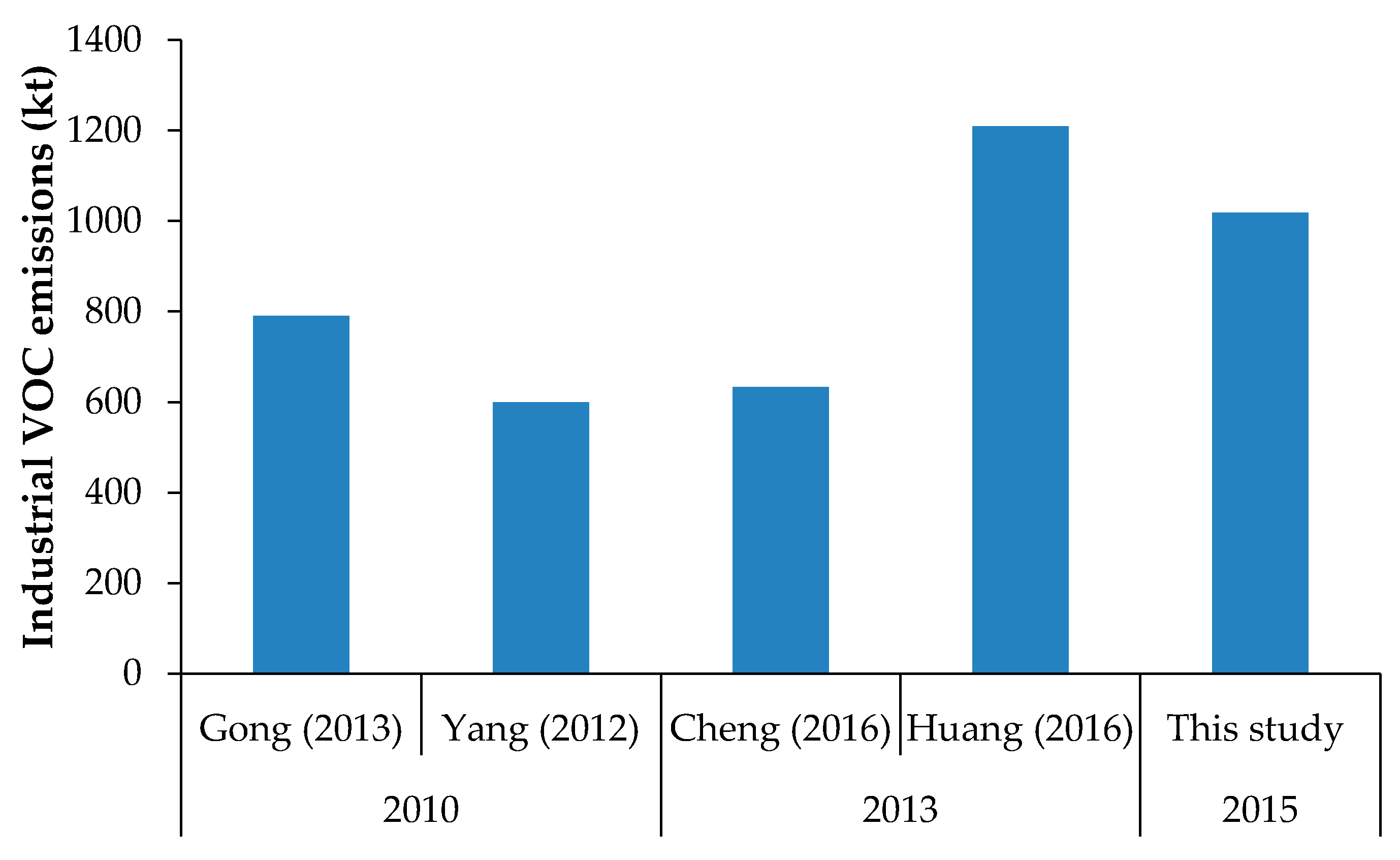
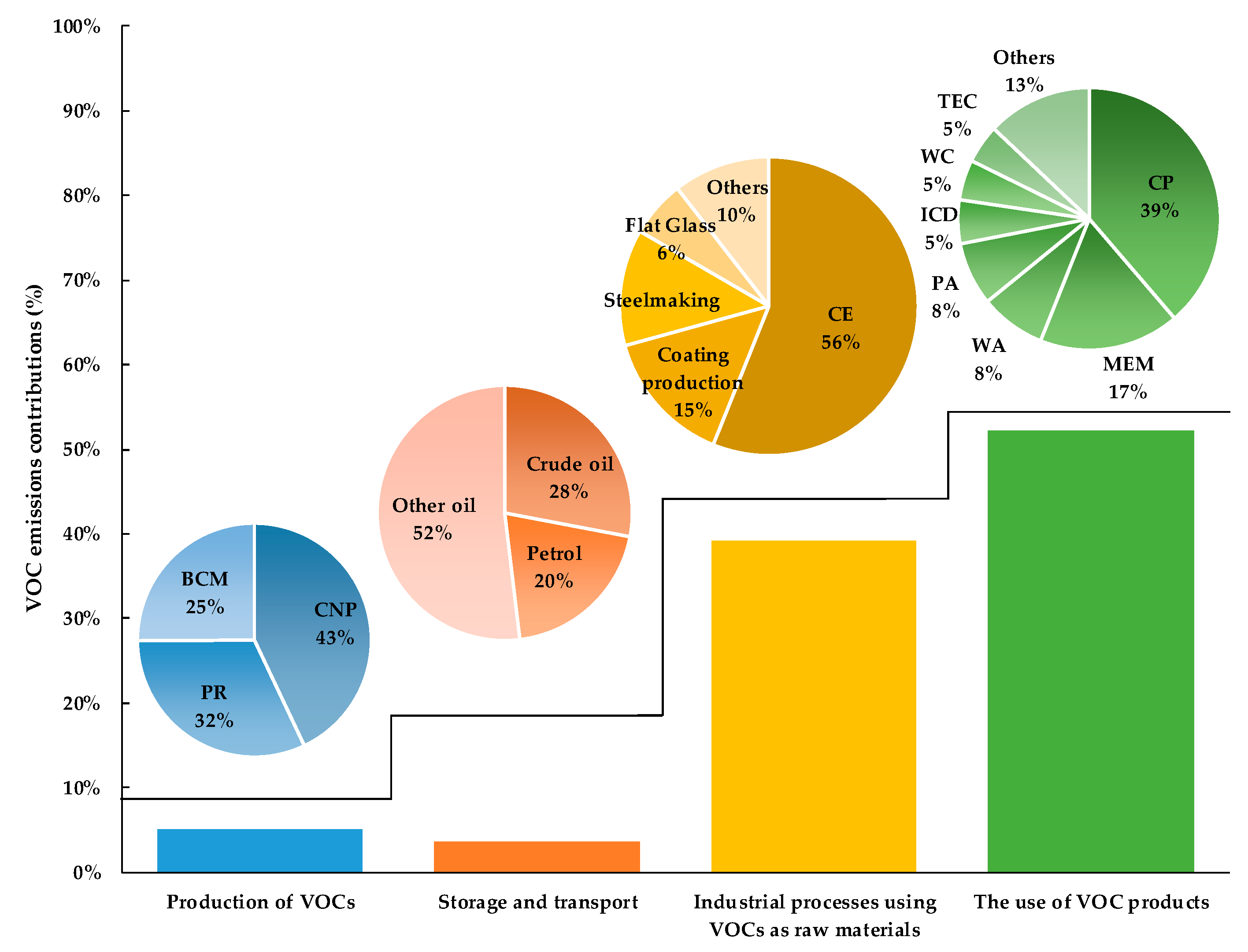
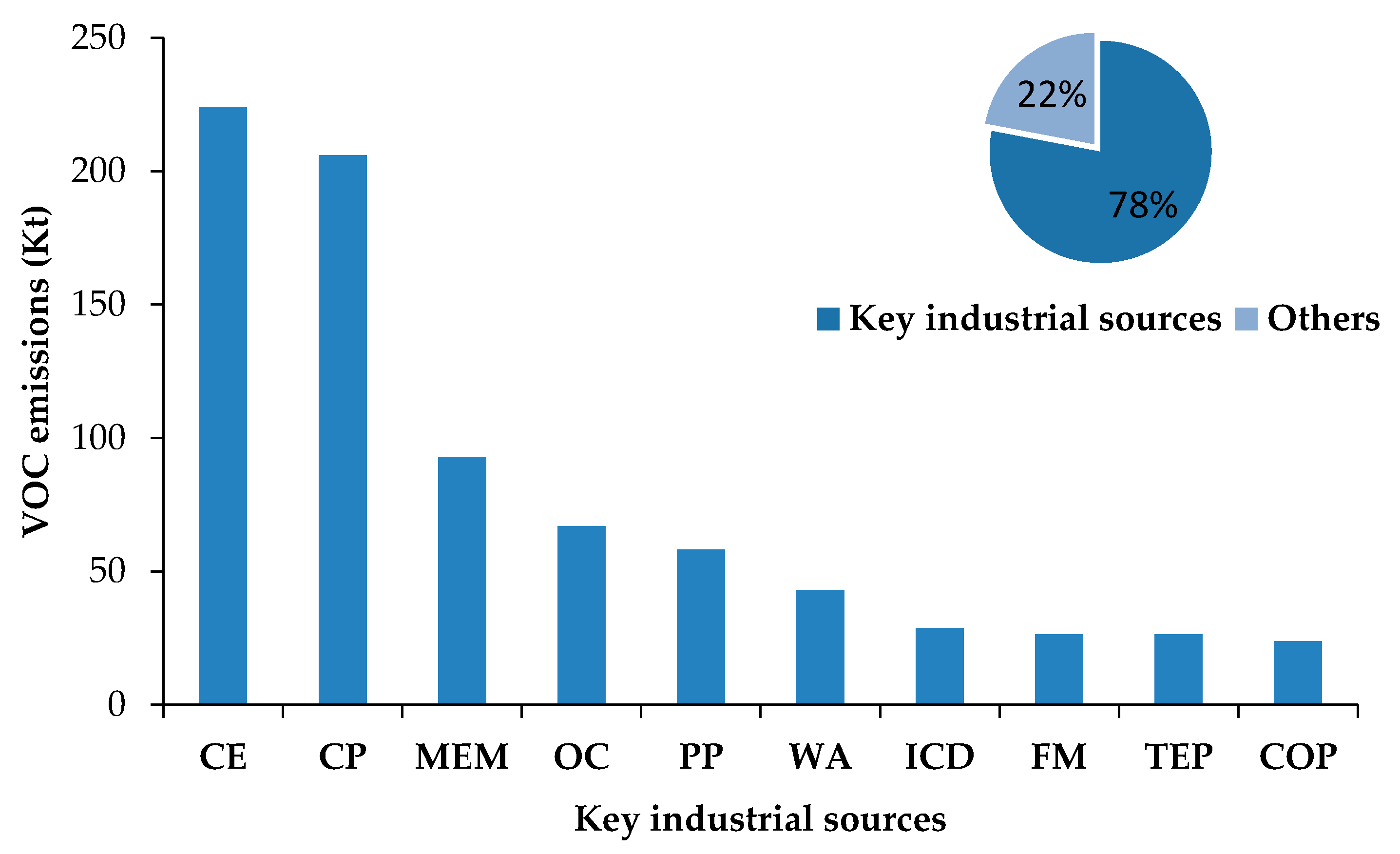
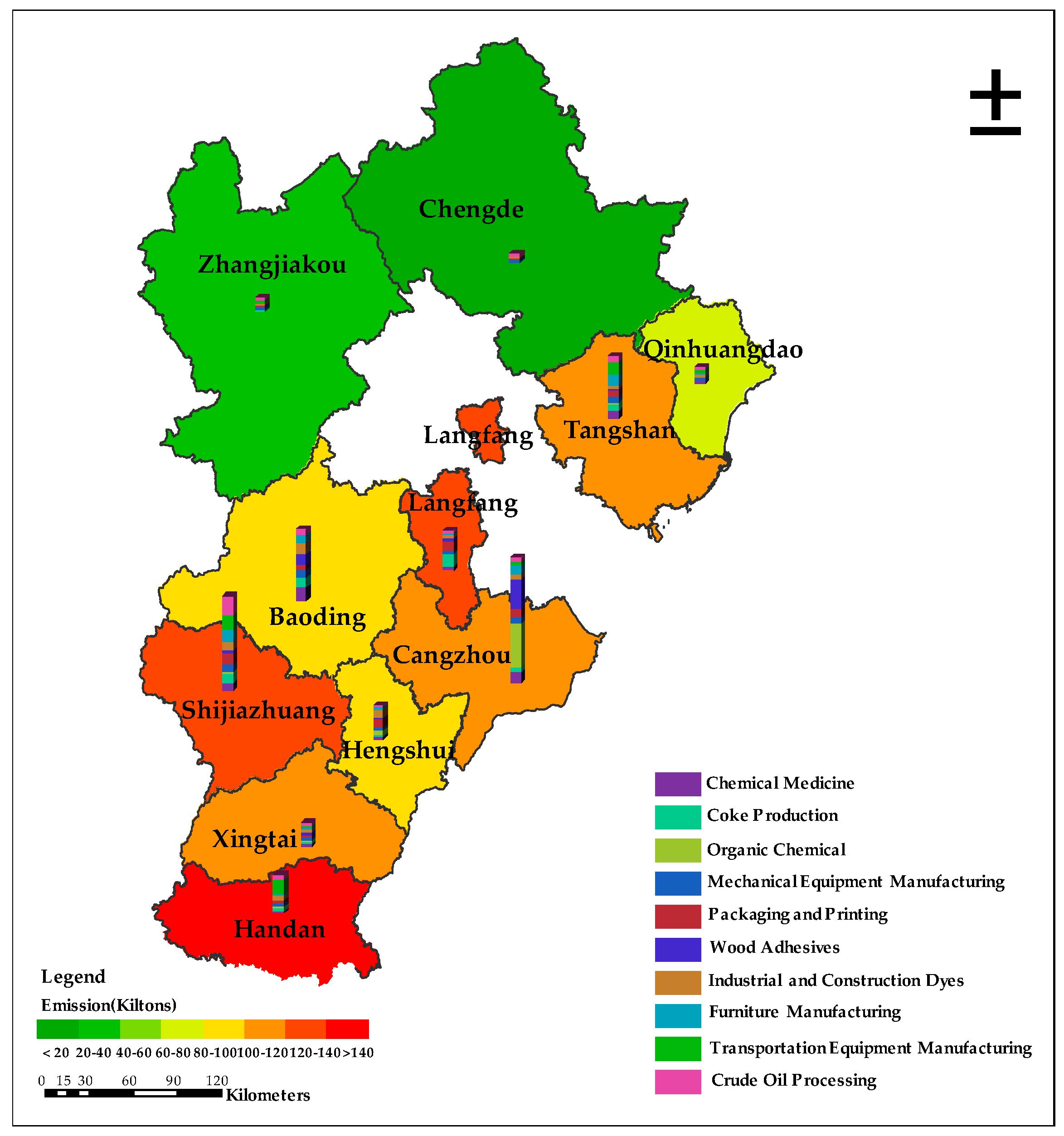
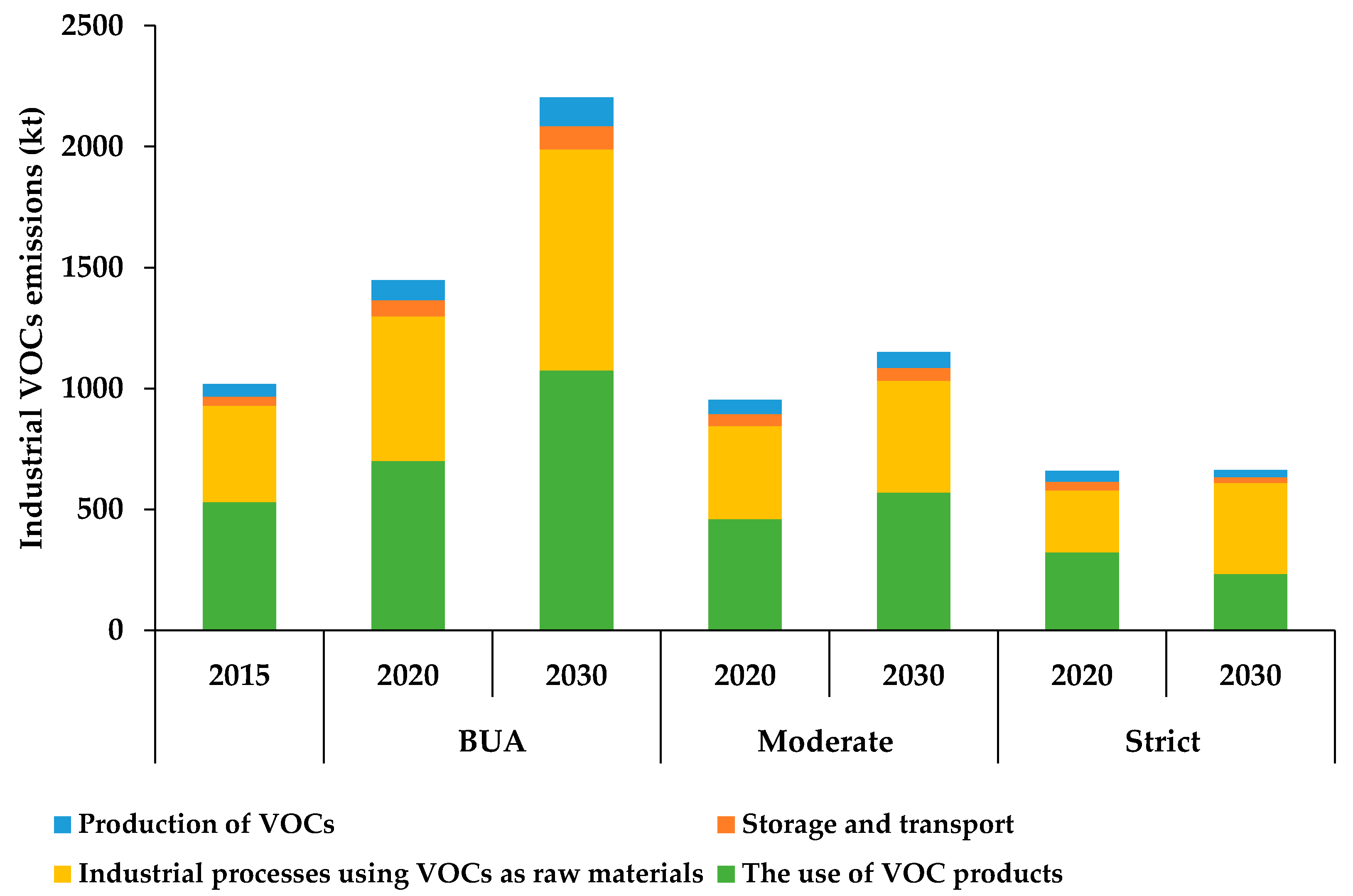
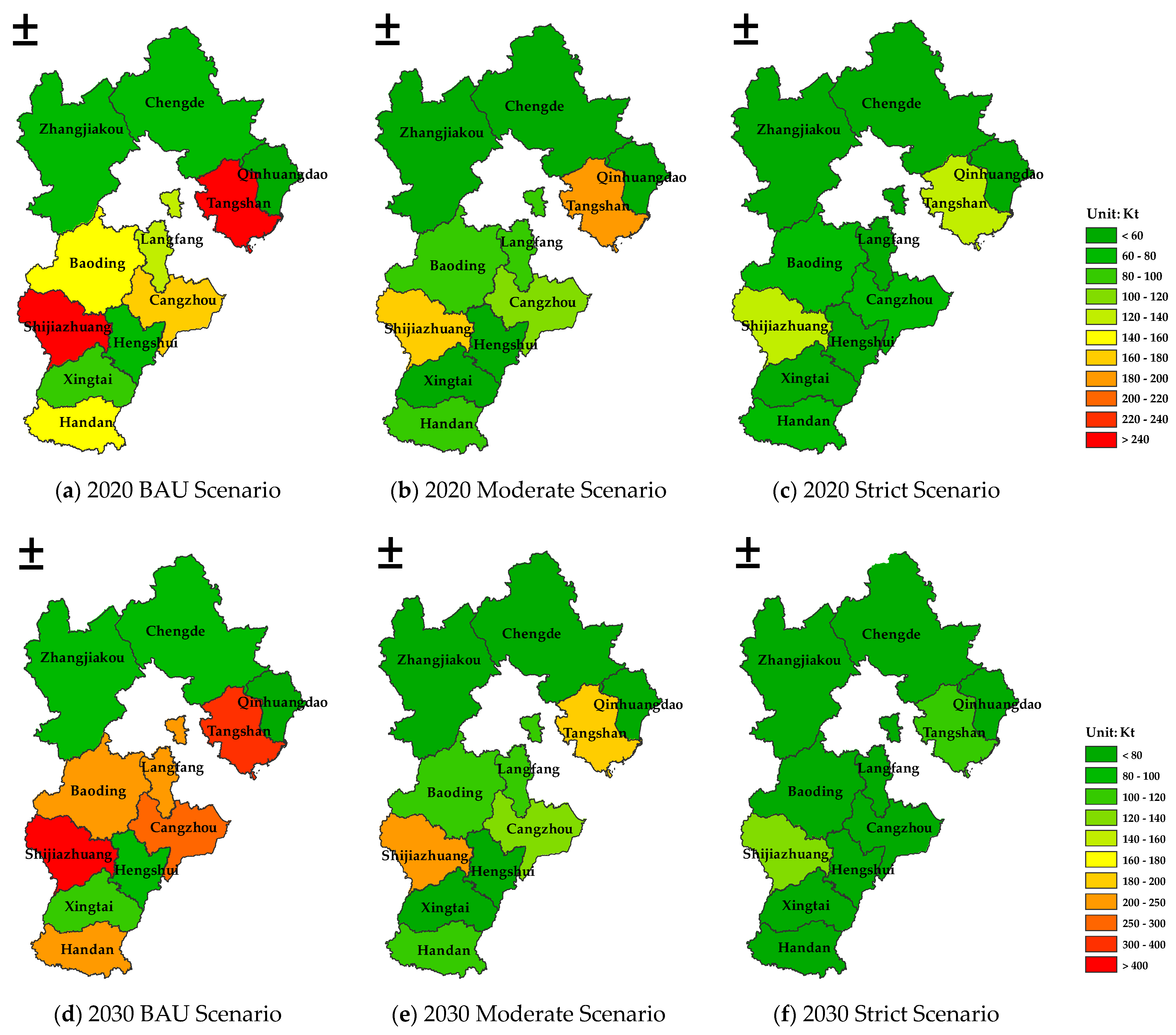
| Sectors | Sources | Reference |
|---|---|---|
| Production of VOCs | Crude oil production | [32] |
| Natural gas production | [32] | |
| Crude oil processing volume | [41] | |
| Methanol production | [42] | |
| Benzene production | [32] | |
| Output of synthetic ammonia | [32] | |
| Storage and transport | Output of petroleum products | [39] |
| Import and export of oil | [39] | |
| Industrial processes using VOCs as raw materials | Coating production | [32] |
| Ink production | [43] | |
| Production of primary form plastic | [30] | |
| Production of synthetic rubber | [32] | |
| Output of synthetic fiber | [32] | |
| Production of vegetable oil | [32] | |
| Yield of finished sugar | [32] | |
| Liquor yield | [32] | |
| Beer production | [32] | |
| Alcohol production | [44] | |
| Production of synthetic detergent | [32] | |
| Production of chemical medicine raw medicine | [32] | |
| Production of chemical pesticides | [32] | |
| Tire output | [32] | |
| Cement/lime/gypsum | [32] | |
| Flat glass | [32] | |
| Production of sanitary ceramics | [32] | |
| Steel production | [32] | |
| The use of VOC products | Coke production | [30] |
| Textile auxiliary consumption | [30] | |
| Dye consumption | [30] | |
| Consumption of PU slurry | [44] | |
| Consumption of adhesive | [30] | |
| Pulp production | [44] | |
| Paper product output | [32] | |
| Ink consumption | [32,45] | |
| Consumption of gasoline detergent | [32,45] | |
| Adhesive consumption | [32,45] | |
| Adhesive consumption | [40] | |
| Consumption of wood coatings | [40] | |
| Paint consumption | [32] | |
| Assembly adhesive consumption | [32] | |
| Paint consumption | [30,46] | |
| Adhesive consumption | [30,46] | |
| Building paint consumption | [30,47] | |
| Construction adhesive consumption | [30,46] | |
| Landfill amount | [48] | |
| Amount of waste incineration treatment | [48] | |
| Amount of compost treatment | [48] | |
| Fossil fuel consumption | [32] | |
| Heating fuel consumption | [39] | |
| Industrial and construction fuel consumption | [39] | |
| Laundry | [30] |
| Sectors | Sources | Activity Data | Emission Factors | Unit | Reference |
|---|---|---|---|---|---|
| Production of VOCs | Crude oil and natural gas extraction | Crude oil exploration | 1.5275 | g/kg Crude oil | [33] |
| Natural gas exploration | 0.5 | g/kg Products | |||
| Petroleum refining | Crude oil processing volume | 1.82 | g/kg Products | ||
| Basic chemical raw materials manufacturing | Methanol production | 5.55 | g/kg Products | [49] | |
| Benzene Production | 0.55 | g/kg Products | |||
| Synthesis ammonia | 4.72 | g/kg Products | [33] | ||
| Storage and transport | Oil storage | Crude oil | 0.123 | g/kg Products | [33] |
| Gasoline | 0.156 | g/kg Products | |||
| Oil transportation | Crude oil | 1.6036 | g/kg Products | ||
| Gasoline | 1.6036 | g/kg Products | |||
| Industrial processes using VOCs as raw materials | Coating production | Paint production | 81.4 | g/kg Products | [33] |
| Ink production | Ink production | 50 | g/kg Products | ||
| Production of synthetic materials | Production of primary form plastic | 5.81 | g/kg Products | [5] | |
| Production of synthetic rubber | 7.17 | g/kg Products | [33] | ||
| Polyester | 0.7 | g/kg Products | |||
| Nick | 3.3 | g/kg Products | |||
| Acrylic | 37.1 | g/kg Products | |||
| Other fiber | 13.43 | g/kg Products | |||
| Food and beverage production | Production of vegetable oil | 2.45 | kg/t | ||
| Yield of finished sugar | 8 | g/kg sugar | |||
| Liquor yield | 16.26 | kg kL−1 | [50] | ||
| Beer production | 0.43 | kg kL−1 | [50] | ||
| Alcohol production | 32.1 | kg kL−1 | [49] | ||
| Commodity production | Production of synthetic detergent | 0.025 | kg/t | [50] | |
| Manufacture of chemical drug raw drugs | Production of chemical drug raw drugs | 430 | g/kg Products | [33] | |
| Tire manufacturing | Tire production | 0.91 | Kg/a | ||
| Manufacture of cement, lime and gypsum | Cement/lime/gypsum | 0.177 | g/kg Products | ||
| Glass and glass product manufacturing | Flat glass | 4.4 | g/kg Products | ||
| Steelmaking | Steel production | 0.2 | g/kg Steel | ||
| The use of VOC products | Coke production | Mechanical coking | 2.96 | g/kg Coke | [33] |
| Indigenous coking | 5.36 | g/kg Coke | |||
| Textile Printing and dyeing | Textile auxiliary consumption | 98 | kg/t | [49] | |
| Dye consumption | 81.4 | g/kg dyes | |||
| Synthetic Leather Manufacturing | Consumption of PU slurry | 245 | kg/t | [50] | |
| Shoe Making | Consumption of adhesive | 670 | kg/t | ||
| Papermaking and paper Products | Pulp production | 3.1 | g/kg Pulp | [33] | |
| Paper product output | 0.1 | kg/t Products | |||
| Printing and packaging printing | Ink consumption(new) | 750 | g/kg Ink | ||
| Ink consumption (traditional) | 100 | g/kg Ink | |||
| Consumption of gasoline detergent | 1000 | kg/t | |||
| Adhesive consumption | 1385 | kg/t | [26] | ||
| Wood processing | Adhesive consumption | 89 | kg/t | [50] | |
| Furniture manufacturing | Consumption of wood Coatings | 651 | kg/t | [51] | |
| Mechanical equipment manufacturing | Paint consumption | 0.4 | kg/pieces | [33] | |
| Assembly Adhesive Consumption | 89 | kg/t | [49] | ||
| Traffic and transportation equipment manufacturing | Paint consumption (automobile) | 21.2 | kg/car | [33] | |
| Paint consumption (motorcycles) | 1.8 | kg/car | |||
| Paint consumption (Sedan) | 2.43 | kg/car | |||
| Paint consumption (bicycle) | 0.3 | kg/car | |||
| Adhesive consumption | 89 | kg/t | [50] | ||
| Architectural decoration | Construction paint Consumption (water-based) | 120 | g/kg Coating | [33] | |
| Construction Paint consumption (solvent type) | 450 | g/kg Coating | |||
| Construction adhesive consumption | 62 | kg/t | [50] | ||
| Waste disposal | Landfill Amount | 0.23 | g/kg Rubbish | [33] | |
| Amount of waste incineration treatment | 0.74 | g/kg Rubbish | |||
| Amount of compost treatment | 0.74 | g/kg Rubbish | |||
| Clothes dry cleaning | Ethylene chloride consumption | 1000 | g/kg | ||
| Stationary source combustion | Fossil fuel (coal) | 0.15 | g/kg Coal | ||
| Thermal power (Fuel oil) | 0.13 | g/kg Fuel oil | [33] | ||
| Thermal power (coal gasification) | 0.00044 | g/m3 | |||
| Thermal power (liquefied petroleum gas) | 0.034 | g/m3 | |||
| Thermal power (natural gas) | 0.045 | g/m3 | |||
| Heating fuel (coal) | 0.18 | g/kg Coal | |||
| Heating fuel (fuel oil) | 0.2 | g/kg Fuel oil | |||
| Heating fuel (coal gasification) | 0.00044 | g/m3 | |||
| Heating fuel (liquefied petroleum gas) | 0.5 | g/m3 | |||
| Heating fuel (natural gas) | 0.088 | g/m3 | |||
| Industrial and construction fuels (coal) | 0.39 | g/kg Coal | |||
| Industrial and construction fuels (fuel oil) | 0.35 | g/kg Fuel oil | |||
| Industrial and construction fuels (coal gasification) | 0.00044 | g/m3 | |||
| Industrial and construction fuels (liquefied petroleum gas) | 0.48 | g/m3 | |||
| Industrial and construction fuels (natural gas) | 0.088 | g/m3 |
| GDP (Billion Yuan) | Population (Million) | Urbanization Rate (%) | |
|---|---|---|---|
| 2015 | 2980.6 | 74.24 | 51.33 |
| 2020 | 5280.5 | 76.87 | 54.2 |
| 2025 | 5863.3 | 80.49 | 57.52 |
| 2030 | 8223.6 | 83.76 | 60.46 |
| Scenarios | Scenario Description |
|---|---|
| BAU scenario | Based on the 2015 emission level to project future emissions, assuming that the control technologies maintain unchanged, with no additional measures being implemented |
| Moderate scenario | Key industrial sectors (large-scale enterprises of chemical medicine, coke production, mechanical equipment manufacturing, organic chemical, packaging and printing, wood adhesives, industrial and construction dyes, furniture manufacturing, transportation equipment manufacturing, and crude oil processing) adopt the best available control technologies and clean production |
| Strict scenario | All industrial sectors (100%) adopt the best available control technologies and clean production |
| Sources | Control Technologies | Emission Reduction Efficiency (%) | |
|---|---|---|---|
| 2020 | 2030 | ||
| Chemical medicine | Condensation/adsorption/catalytic combustion technology | 60–70 | 80–90 |
| Coke production | Condensation recovery/catalytic combustion/adsorption | 50–65 | 70–85 |
| Mechanical equipment manufacturing | Adsorption and concentration of activated carbon + catalytic combustion/thermal combustion | 50–65 | 70–85 |
| Organic chemical | Condensation/adsorption/catalytic combustion technology/spray absorption + cooling dehumidification + activated carbon adsorption | 60–70 | 80–90 |
| Packaging and printing | Adsorption recovery/catalytic combustion/environmentally friendly raw material substitution | 55–65 | 75–90 |
| Wood adhesives | Substitution of environmental protection materials/activated carbon adsorption/low temperature plasma | 55 | 75 |
| Industrial and construction dyes | Adsorption/combustion | 45–60 | 70–85 |
| Furniture manufacturing | Wheel concentrated combustion/adsorption/environmentally friendly raw materials | 50–65 | 75–85 |
| Transportation equipment Manufacturing | Adsorption and concentration of activated carbon + catalytic combustion/thermal combustion | 50–65 | 80–90 |
| Crude oil processing | Oil and gas recovery system/adsorption concentration + catalytic combustion | 55–70 | 75–90 |
| Other sources | Adsorption/combustion/biological treatment | 51–50 | 70–80 |
| Source | Production of VOCs | Storage and Transport | Industrial Processes Using VOCs as Raw Materials | The Use of VOC Products | Total Industrial VOCs |
|---|---|---|---|---|---|
| Emissions (kt) | 51.2864 | 36.4872 | 399.582 | 530.439 | 1017.795 |
| Sectors | Uncertainty (95% Confidence Interval) |
|---|---|
| Production of VOCs | [−38%, +59%] |
| Storage and transport | [−57%, +85%] |
| Industrial processes using VOCs as raw materials | [−39%, +67%] |
| The use of VOC products | [−63%, +90%] |
Publisher’s Note: MDPI stays neutral with regard to jurisdictional claims in published maps and institutional affiliations. |
© 2021 by the authors. Licensee MDPI, Basel, Switzerland. This article is an open access article distributed under the terms and conditions of the Creative Commons Attribution (CC BY) license (https://creativecommons.org/licenses/by/4.0/).
Share and Cite
Guo, X.; Shen, Y.; Liu, W.; Chen, D.; Liu, J. Estimation and Prediction of Industrial VOC Emissions in Hebei Province, China. Atmosphere 2021, 12, 530. https://doi.org/10.3390/atmos12050530
Guo X, Shen Y, Liu W, Chen D, Liu J. Estimation and Prediction of Industrial VOC Emissions in Hebei Province, China. Atmosphere. 2021; 12(5):530. https://doi.org/10.3390/atmos12050530
Chicago/Turabian StyleGuo, Xiurui, Yaqian Shen, Wenwen Liu, Dongsheng Chen, and Junfang Liu. 2021. "Estimation and Prediction of Industrial VOC Emissions in Hebei Province, China" Atmosphere 12, no. 5: 530. https://doi.org/10.3390/atmos12050530
APA StyleGuo, X., Shen, Y., Liu, W., Chen, D., & Liu, J. (2021). Estimation and Prediction of Industrial VOC Emissions in Hebei Province, China. Atmosphere, 12(5), 530. https://doi.org/10.3390/atmos12050530







